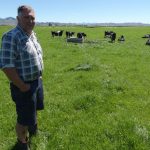
For Austin and Jenna Schulte, of rural Benton County, that means building a creamery where they can use milk from their 186 Holsteins to produce Gouda, Jarlsberg, quark and cheddar cheeses.
“We have to do something different or we’ll be done,” Jenna Schulte told Xochitl Torres Small, undersecretary for rural development for the U.S. Department of Agriculture, during a tour last week of the farm.
The Cedar Rapids Gazette reports the dairy has been awarded a $36,000 Value-Added Producer Grant from the USDA to create a business plan and conduct a feasibility study on making and marketing cheese produced on site.
It’s one of 21 projects that have received $74.7 million in loans or grants to improve infrastructure and expand business in rural Iowa. Much of the investment goes to rural hospitals to buy equipment or recover from the economic impact of the pandemic, and to water treatment and distribution projects. The funding comes from several federal pots, including the American Rescue Plan Act, disaster aid and regular rural development funds.
Torres Small, accompanied by Theresa Greenfield, the USDA’s Iowa coordinator for Rural Development, also planned to visit three other grant recipients: LDJ Manufacturing in Pella; Mahaska County Hospital in Oskaloosa; and the William Penn University nursing school in Oskaloosa.
The Schultes bought their small dairy operation in 2010, the same year their oldest son, Caleb, was born. But American cow milk consumption is slowing and there’s been an oversupply, causing prices to plummet. The pandemic brought further volatility.

From more than 70,000 dairy producers in 2003, the United States had about 31,000 in 2020, the American Farm Bureau Federation reported.
The Schultes decided it might make sense to stop sending their milk to the Wapsie Valley Creamery in Independence and start using it to make cheese they could sell themselves. Construction on the creamery will start this summer, Austin Schulte said.
If everything works out as planned, the Schultes likely will reduce the number of dairy cows, which will cut down on the six-plus hours a day they now spend milking.
Torres Small, a former U.S. representative from New Mexico, said one of the goals of USDA Rural Development is to help farmers find ways to keep farming, rather than being forced to sell their land.
“Farmers figured out how to work as efficiently as possible and as a result, we see a lot of consolidation and you see small farmers have to take on other jobs,” she said. “Even in record years, like last year, you see almost 50 percent of farmers lost money. You know that’s not sustainable for our whole country.”
A handful of community members and industry representatives showed up to talk with Torres Small, including Mariah Busta, farm relations manager for the Midwest Dairy Association, which represents more than 4,800 dairy farms.
“Can you talk a little bit about sustainability?” Busta asked.
Some farmers are implementing sustainable farming practices, such as reduced tillage or cover crops, and receiving compensation through carbon trading markets, Torres Small said. The USDA’s partnerships for climate-smart commodities will invest $3.1 billion on 141 pilot projects that test the production and marketing of climate-smart commodities.
“It’s about working to fund people’s ideas about reducing greenhouse gas emissions and also turn that into a market,” she said.


















